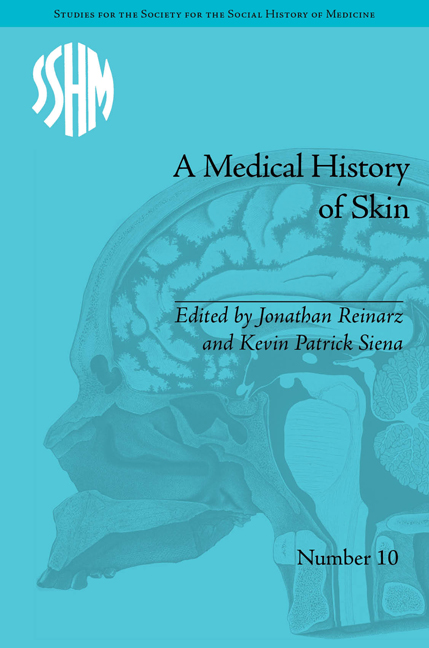Book contents
- Frontmatter
- CONTENTS
- List of Contributors
- List of Figures and Tables
- Scratching the Surface: An Introduction
- Part I The Emerging Skin Field
- Part II Skin, Stigma and Identity
- 5 The Moral Biology of ‘the Itch’ in Eighteenth-Century Britain
- 6 Syphilis, Backwardness and Indigenous Skin Lesions through French Physicians' Eyes in the Colonial Maghreb, 1830–1930
- 7 Discovering the ‘Leper’: Shifting Attitudes towards Leprosy in Twentieth-Century Uganda
- 8 Sex and Skin Cancer: Kaposi's Sarcoma Becomes the ‘Stigmata of AIDS’, 1979–83
- Part III Skin, Disease and Visual Culture
- Afterword: Reading the Skin, Discerning the Landscape: A Geo-historical Perspective of our Human Surface
- Notes
- Index
7 - Discovering the ‘Leper’: Shifting Attitudes towards Leprosy in Twentieth-Century Uganda
from Part II - Skin, Stigma and Identity
- Frontmatter
- CONTENTS
- List of Contributors
- List of Figures and Tables
- Scratching the Surface: An Introduction
- Part I The Emerging Skin Field
- Part II Skin, Stigma and Identity
- 5 The Moral Biology of ‘the Itch’ in Eighteenth-Century Britain
- 6 Syphilis, Backwardness and Indigenous Skin Lesions through French Physicians' Eyes in the Colonial Maghreb, 1830–1930
- 7 Discovering the ‘Leper’: Shifting Attitudes towards Leprosy in Twentieth-Century Uganda
- 8 Sex and Skin Cancer: Kaposi's Sarcoma Becomes the ‘Stigmata of AIDS’, 1979–83
- Part III Skin, Disease and Visual Culture
- Afterword: Reading the Skin, Discerning the Landscape: A Geo-historical Perspective of our Human Surface
- Notes
- Index
Summary
Some assume it is in humanity's nature to be disturbed by difference and to stigmatize signs of difference upon the skin. Leprosy, in particular, has long been regarded as the ultimate manifestation of stigma growing from a disfigured external appearance. Belief in the universal stigmatization of leprosy has become so entrenched in the modern Western world that it has become a myth in itself. Yet in reality there is no universal idea of what constitutes a ‘normal’ human, and as such no universal response to the disfiguring symptoms that mark a ‘leper’.
This chapter draws upon missionary and government archival materials, anthropological texts and patient interviews in order to understand why leprosy sufferers were feared or accepted in twentieth-century Uganda. It traces ideas of leprosy in Britain and Uganda and explores how they interacted to shape attitudes towards the ‘leper’ among each of the four Ugandan ethnic groups whose districts contained large-scale leprosy settlements. These settlements were founded by Christian missionaries in the early 1930s and housed primarily the Bakiga of south-western Uganda, the Baganda of central Uganda and the Basoga and Iteso of eastern Uganda.
It was during the nineteenth and twentieth centuries that the British middle class acquired the ideas about leprosy that influenced the missionaries who founded Ugandan leprosy settlements, and who later shaped policies and influenced Ugandan concepts of the disease. The Bakiga saw their concept of leprosy shift most radically with missionary intervention, from an initial acceptance of leprosy sufferers in the 1920s to a deep fear of leprosy by the 1960s.
- Type
- Chapter
- Information
- A Medical History of SkinScratching the Surface, pp. 99 - 112Publisher: Pickering & ChattoFirst published in: 2014



